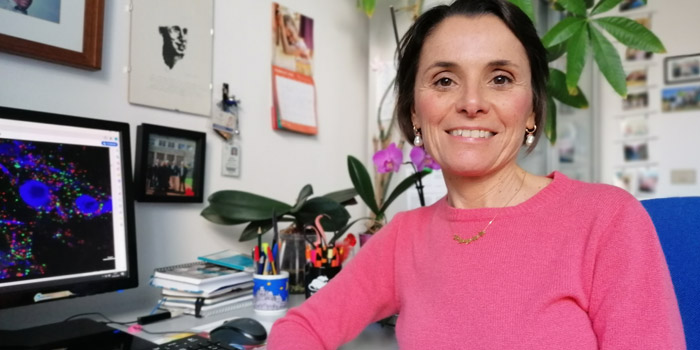By Guillermo Moreno-Sanz

Dr. Moreno-Sanz has authored more than 30 scientific articles and 3 patents describing the role of the endocannabinoid system in pain perception. Graduated in Biochemistry and Organic Chemistry from the University of Zaragoza, he obtained his PhD in Neuroscience from the Complutense University of Madrid, in Spain. He gained extensive international experience with long-term fellowships in the Netherlands, Italy, and the United States, developing most of his academic career at the University of California, Irvine, where he discovered a new class of cannabinoid analgesic with high clinical potential. In 2017, he acted as a consultant to the National Academies of Sciences of the United States in the preparation of the report "The health effects of cannabis and cannabinoids" and later founded Abagune Research to offer scientific advice and R&D solutions to the international cannabis industry. In 2020 he assumes the scientific and medical direction of Khiron Life Sciences in Europe.
Meet the Experts is a series of interviews conducted by experts from the field of Cannabis to world leaders in research and clinical practice of Cannabis as medicine.
Miriam Melis is an Associate Professor at the University of Cagliari, Italy. She holds a PharmD as well as a PhD in Neuroscience. During her career, Miriam worked for two years as a Research Fellow at the Ernest Gallo Clinic and Research Center at the University of California in San Francisco and was a Visiting Scientist at Lund Universitet Wallenberg Neuroscience Center in 2011.
Her current research is focused on understanding neurobiological underpinnings (e.g., adaptations of both dopamine pathway and endocannabinoid system) of resilience and susceptibility to neuropsychiatric disorders (e.g., substance use disorder, antisocial behavior, anxiety, depression). Her group discovered that dopamine neurons can synthesize and release lipid signaling molecules (i.e. endocannabinoids and their cognate molecules) under both physiological and pathological conditions, and that the effects of in utero THC on the function of the dopamine system are similar to those of cocaine and alcohol.
Among her publications, 41 research papers and 4 book chapters are in the cannabinoid field. In 2017, she edited "Endocannabinoids and Lipid Mediators in Brain Functions" published by Springer. In 2020, Miriam has received the Gill Transformative Investigator Award for her impressive contributions to neuroscience research performed in cannabis.

Guillermo Moreno-Sanz: Thank you Miriam for taking the time to participate in this series of interviews. Tell us a bit about how did you first got involved with cannabinoid research?
Miriam Melis: I joined the laboratory of electrophysiology at the Department of Neuroscience "Bernard B. Brodie" (University of Cagliari, Italy) at the beginning of 1996 under the mentorship of Gian Luigi Gessa. The team was starting to investigate the acute effects of cannabinoids, including Δ9-tetrahydrocannabinol (THC), on the activity dopamine neurons involved in the mechanism of reward. We discovered that cannabinoids act on these neurons similarly to alcohol, nicotine and morphine, which represents the hallmark of acute recreational effects shared by the diverse drugs of abuse. Subsequently, we found a hypodopaminergic state during acute withdrawal caused by the chronic use of THC that could underlie a state of dysphoria, a neurobiological feature similar to what the team had earlier on described in acute withdrawal from chronic alcohol and morphine consumption. Being dopamine neuronal function the focus of my research interest at that time, during my postdoctoral studies in the lab of Anto Bonci at the Gallo Center at UCSF, I investigated the effects of a single in vivo exposure to alcohol in the modulation of neuronal excitability and plasticity at synapses impinging upon these neurons on brain slices.
GMS: What aspects of the endocannabinoid physiology interested you more?
MM: Upon my return to Cagliari in 2002, as endocannabinoid retrograde signaling had just been discovered a year earlier, my interest in these molecules as possible fine regulators of dopamine neuron function in health and disease began. My main interest relates to how these two neurotransmitter systems interact, particularly how endocannabinoids play a role in the mechanisms conferring vulnerability and resilience to neuropsychiatric disorders.
GMS: Your research is focused on the role of the endogenous cannabinoid system in the susceptibility and resilience to neuropsychiatric dissorders. There is growing concern regarding the use of cannabis (particularly in the youth) and the incidence of mental illness and dual pathologies. Do you think there are inherent risks for public health in granting the general population access to cannabis?
MM: Similarly to most drugs, cannabis use has both its benefits and risks, and can potentially lead to a use disorder (CUD), as described in the latest version of the diagnostic and statistical manual of mental disorders, which affects only a small percentage (~11%) of the people using it. Interestingly, cocaine users developing a use disorder are only about 17% but no one argues about its abuse liability. In addition, population surveys carried out in US and EU have provided epidemiological data showing that the percentage of cannabis users developing a CUD increases to 17% as the age of onset decreases (usually during teenage years) and raises to 25-50% in those using it on a daily basis. In addition, brain imaging studies are revealing the effects of cannabis use in teens on grey matter volume and cortical architecture in both short and long term. Thus, there is a consensus on how vulnerable the developing brain is to the detrimental effects of cannabis, and this is because of the fundamental roles played by the endogenous cannabinoid system throughout development. It is not surprising that early exposure to cannabis may be detrimental to neurodevelopment and could increase the risk of mental illness. Because of the misleading information available on the internet, both adults and the youth should be educated with science-based evidence before granting access to this substance.
GMS: And, at the same time, the endocannabinoid system (ECS) is being studied as a target to fight anxiety, depression and addictive behaviors. However, after many years of development, phytocannabinoids still remain the tools we have to target the ECS clinically. Do you think there is therapeutic potential on THC and CBD to treat stress- or drug- related illnesses? What about other ECS-targeting drugs?
MM: Despite the unquestionable therapeutic potential of cannabis-based madicines for many illnesses, as I said earlier all drugs have side effects and risks due to drug-drug interactions. I think that targeting the ECS (e.g. via inhibition of either FAAH, MGL and NAAA, or with NAM of CB1 receptors) would be the most viable approach to minimize adverse reactions and side effects, and to increase the safety window of cannabis-based drugs.
GMS: Translational value of data arising from animal models is often received by clinicians with skepticism, in particular behavioral models. What is your impression regarding preclinical results with cannabinoids in models such as prenatal exposure or alcohol administration?
MM: I understand the skepticism of clinicians when novel data arises from preclinical studies, because there often is a lack of reproducibility along with deficits in statistical analysis that contribute to the gap between experimental and clinical research outcome. However, preclinical animal studies are still fundamental for the development of new drugs. Having said this, as basic researchers, we always keep in mind epidemiological phenomena to better define an animal model and are aware of the many caveats. In my personal experience, a class of drugs marketed to lower blood triglycerides, proved effective in our in vitro and in vivo studies in a mouse model of an inherited form of nocturnal epilepsy, and was effective as add-on therapy in a small clinical trial. In prenatal exposure to cannabis, the recent clinical evidence confirming the association between prenatal cannabis exposure and vulnerability traits similar to those observed in our animal models are reassuring. Consequently, I have a positive attitude towards the insights that can arise from experimental research in animals.
GMS: There is a remarkable presence of Italian cannabinoid researchers, many of which are international figures in Europe or the US. You have had professional experiences abroad, was it a concious decision to come back to Italy? Does most of your funding come from the EU or the italian government?
MM: I intentionally came back to Sardinia because of the positive role model of my mentor Gian Luigi Gessa, who was able to achieve high standards in pharmacological research in Italy after his period in the US in the '70s. Additionally, because the cannabinoid field of research had been so productive, it had an additional value. The opportunity to discuss and collaborate with other italian researchers in the field is still pivotal nowadays. I feel supported by them, although the Italian national funding for scientific and technological research is very scarce. My main funding comes from the region of Sardinia that has financial autonomy and collaborative grants with colleagues abroad (e.g., NIDA grant).
GMS: Italy has a medicinal cannabis program in which the military is responsible for conducting research and producing plant material to be sold in pharmacies around the country. What do you think of giving access to cannabis and cannabinoids to patients through a compounding pharmacy system?
MM: I am familiar with the Italian program that distributes cannabis extracts produced by the Military Chemical Pharmaceutical Plant based in Florence. Since two different extracts (FM-2 e FM-1) have been used by patients, their effects are studied by clinical toxicologists and pharmacologists. Again, because of the adverse reactions, side effects and drug-drug interactions, it is imperative that physicians prescribing medical cannabis and pharmacists dispensing it, have both a rigorous and an updated science-based education, which should be a higher bar than the mere available therapeutic indication regulated by law. Additionally, cannabis-based medicines have therapeutic potential but they need to be prescribed with caution, just like any other drug on the market. Each new drug is subjected to strict and systematic examination by drug agencies (AIFA and FDA in Italy and US, respectively) before accessing the market. This should be the case with cannabis extracts as well.
GMS: At the past Gordon Research Conference (GRC) on cannabinoids celebrated in Barcelona, you organized (together with Dra. Raffaella Tonini) the power hour, an informal session that provides an open forum to discuss challenges women face in science and issues of diversity and inclusion. How was the experience?
MM: I was honored to be selected to chair the power hour. Its preparation gave me the opportunity to put the "discrimination" issue in perspective. In fact, since I work in public academia in Italy I see no gender-difference in wages. However, I discovered how common and diverse the unbalance between genders is, from housework to the workplace across the EU. The whole experience was terrific because I could also feel that this is an important matter to discuss for both men and women in our GRC community. The attendees actually required me to bring up to GRC staff attention that this "hour" should last longer (it was expected to last 1 hr though we extended to 2 hours) and should be mandatory, instead of happening during the free time after lunch. Our cannabinoid GRC community felt this allocated time to be as important as the science itself.
GMS: You were selected to co-chair the GRC in 2023 together with Mario Van der Stelt from the University of Leiden. As discussed in the Power Hour, you will be the third woman in over 20 years to do so. I understand this is a biased question I would not be asking Mario, but does it feel like an extra responsibility? Do you have any advise for your female students or the female students reading this interview who aspire to have a leading role in sciences?
MM: Irrespective of the fact that I am a woman, I think that it is a huge responsibility to follow the path of my esteemed predecessors in organizing a GRC, which is at the frontiers of science by definition. And yes, being a woman adds an extra responsibility! The current situation of women in biomedical research is not as bad as it used to be up to a decade ago, but there is still a lot of work to do. I do not think that imposing a "gender-based equal opportunity" like in politics helps gender discrimination in research. Women should be able to reach top positions based on their merit. And once they are there, they should not behave as if they were men. However, the imposed gender-equality can become a problem when at apical positions there are women simply because of their gender and not because of their competence. When it comes to me, I do not think I have an implicit bias as my general advice to my students is the code of honor of George Meyers: "show up, work hard, be kind, and take the high road". But since you ask, if I have to add something to female students, it is to find a partner that understands that research makes you actually happy, and that is part of "your deal".
GMS: Thank you so much, Miriam, for taking the time to talk to us and congratulations again for your many recent accomplishments!


